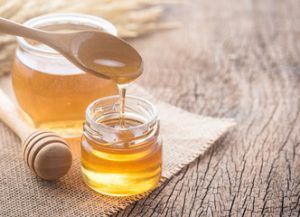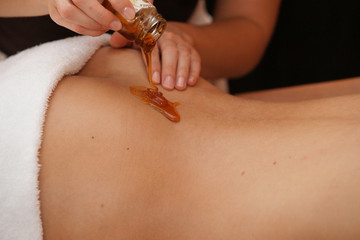Honey is the most valued and appreciated natural product introduced to humankind since ancient times. The use of honey by humans was documented some 8000 years ago in cave paintings. It is a by-product of flower nectar and aero-digestive tract of honey bees. Since ages, honey is consumed for its taste and therapeutic properties.
From the start of human civilizations, Greeks, Egyptians, Chinese, Romans, Mayans, Babylonians and Indians have relied on honey for a number of its medicinal properties. Indian system of Ayurveda has called it nature’s most remarkable gifts to humans. Ayurveda is a combination of two words – “ayus” meaning “life” and “veda” refers to “a system of knowledge”. Hence Ayurveda translates to “a system of life”.
According to one of the shlokas in Ayurveda,
“Vaatalam guru sheetam cha raktapittakaphapaham |
Sandhatru cchedanam ruksham kashayam madhuram madhu||.”
“It has the sweetness (madhura rasa) with added astringent as end taste (kashaya anurasa). It is heavy (guru guna), dry (ruksha) and cold (sheeta). Its effects on doshas are as follows: It aggravates vata, scrapes kapha and normalizes pitta and rakta. It promotes healing process.”
Types of Honey

In the ancient texts of Ayurveda, eight types of honey are described depending on the type of bee which produces it and the nature of honey in treating various diseases. These are,
- Makshikam – This honey is collected by small bees. It is very light and dry in nature. It is used in the treatment of eye diseases, hepatitis, piles, asthma, cough and tuberculosis.
- Bhraamaram – It is collected by large bees and is sticky in nature. It is used when there is blood in the vomit.
- Kshoudram – It is collected by medium sized bees. It is light and cold in nature. It is used in the treatment of diabetes.
- Pauthikam – This honey is collected by very large bees from the nectar of poisonous flowers. It is used to treat diabetes and urinary infections. It also acts as sedative and reduces fat.
- Chathram – This honey is heavy and cold in nature. It is useful in gout and leucoderma (Shwitra).
- Aardhyam – It is effective for treating eye diseases, cough and anemia. It may cause arthritis.
- Ouddalakam – It is useful in skin diseases and modulation of voice (swarashudhi). It is also used in leprosy and poisoning cases.
- Daalam – It is dry in nature. It aids digestion and helps in the treatment of cough, vomiting and diabetes.
Raw vs Processed Honey
Ayurvedic doctors (viadya) from the very beginning have invested a lot of time and efforts in studying how honey can be used to treat a variety of diseases. They have since used the raw honey in their research. In Ayurveda, it is advisable to use the natural, unprocessed honey collected directly from the jungles. Though some form of processing is required to make the honey suitable for various diseases, no synthetic substance is added. The processing is normally in the form of how the honey is stored and the consistency required to treat various ailments. Different types in which the honey is processed according to Ayurveda are,
- Comb honey – Harvested directly from the honeycomb and stored as it is.
- Liquid honey – The wax capping is cut, and the comb is processed in honey centrifuge extractor.
- Granulated honey – The honey is frozen, water elements are separated which leaves behind honey granules.
- Creamed honey – It is blended of 1 part of granulated honey and 9 parts of liquid honey which is stored at 57 degrees until it becomes firm.
- Chunk honey – This is achieved by storing the comb honey in a jar and pouring liquid honey over it.
Honey and its curative properties

In ancient ayurvedic texts, honey is known as “Madhu”, which is one of the most important medicines in Ayurveda. Honey can be used both internally and externally to treat diseases. In most ayurvedic preparations, honey is used as a natural preservative and sweetener. It is used with many medicines to improve the efficacy and to balance the side effects caused by those medicines.
Let’s look at the benefits of honey and how it aids the treatment of various ailments in the human body.
1. Heart
Reducing inflammation is the most important effect of honey. Raw honey contains flavonoids, polyphenols and many other antioxidant micronutrients. These antioxidants help to boost the natural ability of the body to reduce inflammation. As a result, the plaque buildup in the arteries is reduced, which helps to protect against a heart attack or a stroke. Traditional ayurvedic experts recommend honey for cardiac pain and palpitation of the heart.
2. Anemia
Anemia is characterized by deficiency of quality and quantity of hemoglobin in the red blood cells. Hemoglobin is responsible for carrying oxygen from the lungs to the tissues in the human body. Thus, when the hemoglobin is unable to carry oxygen, the body develops anemia. Honey contains iron, copper and manganese responsible for building hemoglobin. It is thus considered effective in treating anemia which helps in maintaining the right balance of hemoglobin and red blood cells.
3. Pulmonary health
Pulmonary refers to “related to lungs”. Honey is anti-inflammatory, which helps to reduce inflammation in the bronchial tubes in the lungs and helps you to breathe easily. Also, honey contains a mixture of ‘higher’ alcohols and ethereal oil and the vapors given off by them are soothing and aids breathing in asthma patients. It is beneficial even if the air flowing over honey is inhaled or eaten. Ayurvedic experts recommend one-year-old honey to treat respiratory diseases.
4. Skin
Ayurvedic scriptures describe honey can be applied externally. Due to its anti-bacterial, anti-fungal and anti-inflammatory properties, honey is considered useful in treating wounds and sores. It aids fast healing and can also be used to treat acne.
5. Cough and sore throat
Honey is highly beneficial to treat irritable coughs and sore throat. As a demulcent (soothing agent), it has a soothing effect inflamed mucous membrane of the upper respiratory tract. As a result, it helps in relieving irritable coughs and difficulty in swallowing. This is the main reason why honey is used in various cough syrups.
6. Insomnia
Raw honey has sedative properties. It is recommended to take 2 teaspoons of honey in a cup of water before going to bed, which helps you to sleep better.
7. Oral health
According to ayurvedic experts, honey is beneficial in keeping the mouth healthy. Honey keeps the gums healthy by increasing their vascularity. In the case of ulcers, honey is known to aid early healing and prevents sepsis and pyogenic infections, which cause bad odor and pus formation. It is advisable to gargle with honey water to treat gingivitis due to inflammation of gums.
8. Eyes
In the long history of humankind, honey has been used for various eye ailments. Applying a little honey in the eyes daily improves the eyesight. It is also helpful in treating Itching, trachoma, conjunctivitis and other eye-related ailments. It is known to prevent glaucoma, damage to the optic nerve, in its initial stages. It can help improve your eyesight naturally.
9. Stomach
When fecal matter and undigested food are present in the alimentary tract, honey acts as a natural laxative and emetic, which helps to clear the digestive tract. Moreover, it tones up the stomach by helping in proper digestion and prevents stomach diseases. It helps to prevent over-production of hydrochloric acid in the stomach, thus relieving one from nausea, vomiting and heartburn.
10. Old age
This is where honey can be considered to increase the life of an individual. An ancient text mentions that honey is especially useful in providing energy and heat to the body in old age since it is easily digested. It dries up the phlegm, thus helping to clear the system of mucus, which is the main problem in old age. 2 teaspoons of honey in lukewarm water is generally advisable.
Precautions to be taken before using honey
Till now, we have learned how there is an immense scope of using honey in the treatment of various diseases. Though honey is too valuable in our daily lives, some precautions should be taken before using honey.
- Honey should not be heated.
- Honey should not be consumed when you are working in a hot environment.
- Honey should not be mixed with hot and spicy foods. This is because it creates an imbalance of the doshas in the human body.
- Honey should not be mixed with alcoholic beverages.
In Conclusion
Raw honey, after discussing its immense advantages in our day-to-day lives proves to be a simple yet effective remedy in preventing and treating a variety of ailments. Using honey has not only proven beneficial in a medical sense but also it has made its mark as an ingredient in many savoury foods all around the world since generations.
References:
- Traditional and Modern Uses of Natural Honey in Human Diseases: A Review. Tahereh Eteraf-Oskouei, Moslem Najafi. 2013 Jun; 16(6): 731–742.
- Honey and Health: A review of Recent Clinical Research. Saeed Samarghandian, Tahereh Farkhondeh and Fariborz Samini. 2017 Apr-Jun; 9(2): 121–127
- There are Shocking Differences Between Raw Honey and the Processed Golden Honey Found in Grocery Retailers. Karen Foster. 2014
- Seven Health Uses of Honey. Melissa Rasmussen. 2013
- Therapeutic Uses of Honey in Ayurveda. Dr Krishna R.S. 2019
Author’s Bio –
Tejas Shahakar is the SEO and Content manager at Convomax Digital. His experience as a digital marketer includes working on SEO (on & off Page), PPC, social media, and content creation. He is also a health and wellness blogger.
Website: https://www.rawforesthoney.com/








